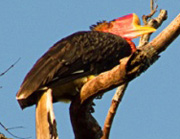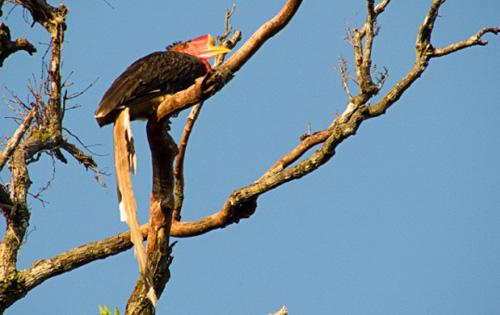
The helmeted hornbill, known locally as rangkong gading, is on the brink of extinction due to excessive hunting, a conservationist has said.
Rangkong
Indonesia director Yokyok “Yoki” Hadiprakarsa said that hunters continue to
hunt the endangered species, targeting its casque, the large decorative growth
of solid keratin on the upper mandible of the bird's bill which sells at a
higher price than elephant ivory on the international market
“Up till
now, we have been unable to stop people hunting hornbill for its casque. It is
an increasingly organized business, making it difficult for law enforcers to
catch the perpetrators. The hunting of the bird continues in forest areas in
Central, East and North Kalimantan, which are difficult to reach and close to
the Malaysian border,” Yokyok told thejakartapost.com on Monday.
The helmeted
hornbill is one of 13 hornbill species in the country. The bird, found in
low-land forests in Sumatra and Kalimantan, is 1.7 meters in length with a
90-centimeter wing span. According to Birdlife International data, the helmeted
hornbill also lives in Brunei, Malaysia, Myanmar, Singapore and Thailand.
During the
2nd Indonesia Bird Researchers and Observers Conference in Yogyakarta at
the beginning of February, the helmeted hornbill was a popular topic.
Yokyok said
that the hunting of helmeted hornbill had sharply increased since 2012 and
added that Rangkong Indonesia had recorded at least 6,000 helmeted hornbills
killed in West Kalimantan due to poaching. Hornbill casques are primarily
smuggled via land and sea routes as authorities often foiled attempts to
smuggle casques abroad by air. “The smuggling attempts are conducted using
hidden routes that are also used to smuggle drugs,” said Yokyok.
The activist
said that most hornbill casques confiscated by security authorities in China
and the US were from Indonesia, reasoning that this may be because, in addition
to weak law enforcement, the world’s helmeted hornbill population was
predominantly based in Indonesia.
Of the
total 2,343 hornbill casques confiscated, around 1,200, or 80 percent, were
from West Kalimantan. It’s really ironic because the bird is the symbol of the
province,” he said.
In 2015,
Switzerland-based environmental organization International Union for
Conservation Nature (IUCN) Red List listed the helmeted hornbill as critically
endangered due to the sharp decline in its populations over recent years. In
2012, IUCN dad listed the species under near-threatened status.
Natural Resources Conservation Agency (BKSDA) West Kalimantan chapter conservation and natural resources data analysis staff member, Subyantoro Tri Pradopo, said that the agency had conducted several operations to stop hornbill poaching. During its last operation in 2015, BKSDA arrested two suspects. Both were sentenced to serve one-year in jail.
Indonesia
Ornitology Association chairman Ign.Pramana Yudha said that Indonesia had been
blessed to have had such a variety of birds, emphasizing, however, that many
were now on the verge of extinction. Around 17 percent of the 2,000 bird
species found in Indonesia will soon be extinct.
“It seems
that our society is not really aware of the impact of excessive bird hunting
and poaching,” he said. (ebf)
